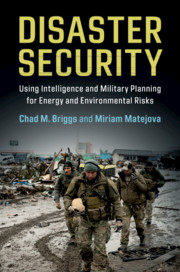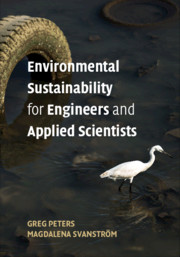Refine listing
Actions for selected content:
2285 results in Ebooks in ecology and environment
Abbreviations
-
- Book:
- Environmental Sustainability for Engineers and Applied Scientists
- Published online:
- 28 February 2019
- Print publication:
- 14 March 2019, pp xii-xiv
-
- Chapter
- Export citation
References
-
- Book:
- Environmental Sustainability for Engineers and Applied Scientists
- Published online:
- 28 February 2019
- Print publication:
- 14 March 2019, pp 227-237
-
- Chapter
- Export citation
7 - Environmental Assessment of Products and Processes
-
- Book:
- Environmental Sustainability for Engineers and Applied Scientists
- Published online:
- 28 February 2019
- Print publication:
- 14 March 2019, pp 139-169
-
- Chapter
- Export citation
9 - Decision-Making
-
- Book:
- Environmental Sustainability for Engineers and Applied Scientists
- Published online:
- 28 February 2019
- Print publication:
- 14 March 2019, pp 198-226
-
- Chapter
- Export citation
2 - The Earth System
-
- Book:
- Environmental Sustainability for Engineers and Applied Scientists
- Published online:
- 28 February 2019
- Print publication:
- 14 March 2019, pp 19-43
-
- Chapter
- Export citation
3 - Impacts of Chemical Pollution
-
- Book:
- Environmental Sustainability for Engineers and Applied Scientists
- Published online:
- 28 February 2019
- Print publication:
- 14 March 2019, pp 44-64
-
- Chapter
- Export citation
Reviews
-
- Book:
- Environmental Sustainability for Engineers and Applied Scientists
- Published online:
- 28 February 2019
- Print publication:
- 14 March 2019, pp ii-ii
-
- Chapter
- Export citation
Reader’s Guide: How Is All of This Connected?
-
- Book:
- Environmental Sustainability for Engineers and Applied Scientists
- Published online:
- 28 February 2019
- Print publication:
- 14 March 2019, pp x-xi
-
- Chapter
- Export citation
8 - Regulatory Structures
-
- Book:
- Environmental Sustainability for Engineers and Applied Scientists
- Published online:
- 28 February 2019
- Print publication:
- 14 March 2019, pp 170-197
-
- Chapter
- Export citation
Copyright page
-
- Book:
- Environmental Sustainability for Engineers and Applied Scientists
- Published online:
- 28 February 2019
- Print publication:
- 14 March 2019, pp iv-iv
-
- Chapter
- Export citation

Disaster Security
- Using Intelligence and Military Planning for Energy and Environmental Risks
-
- Published online:
- 04 March 2019
- Print publication:
- 21 March 2019

Environmental Sustainability for Engineers and Applied Scientists
-
- Published online:
- 28 February 2019
- Print publication:
- 14 March 2019
3 - Energy
-
- Book:
- There Is No Planet B
- Published online:
- 23 January 2019
- Print publication:
- 28 February 2019, pp 59-98
-
- Chapter
- Export citation
Dedication
-
- Book:
- There Is No Planet B
- Published online:
- 23 January 2019
- Print publication:
- 28 February 2019, pp vi-vi
-
- Chapter
- Export citation
Big Picture Summary
-
- Book:
- There Is No Planet B
- Published online:
- 23 January 2019
- Print publication:
- 28 February 2019, pp 195-197
-
- Chapter
- Export citation
6 - People and Work
-
- Book:
- There Is No Planet B
- Published online:
- 23 January 2019
- Print publication:
- 28 February 2019, pp 149-157
-
- Chapter
- Export citation
Introduction
-
- Book:
- There Is No Planet B
- Published online:
- 23 January 2019
- Print publication:
- 28 February 2019, pp 1-10
-
- Chapter
- Export citation
7 - Business and Technology
-
- Book:
- There Is No Planet B
- Published online:
- 23 January 2019
- Print publication:
- 28 February 2019, pp 158-168
-
- Chapter
- Export citation
What Can I Do? Summary
-
- Book:
- There Is No Planet B
- Published online:
- 23 January 2019
- Print publication:
- 28 February 2019, pp 198-199
-
- Chapter
- Export citation
4 - Travel and Transport
-
- Book:
- There Is No Planet B
- Published online:
- 23 January 2019
- Print publication:
- 28 February 2019, pp 99-118
-
- Chapter
- Export citation
